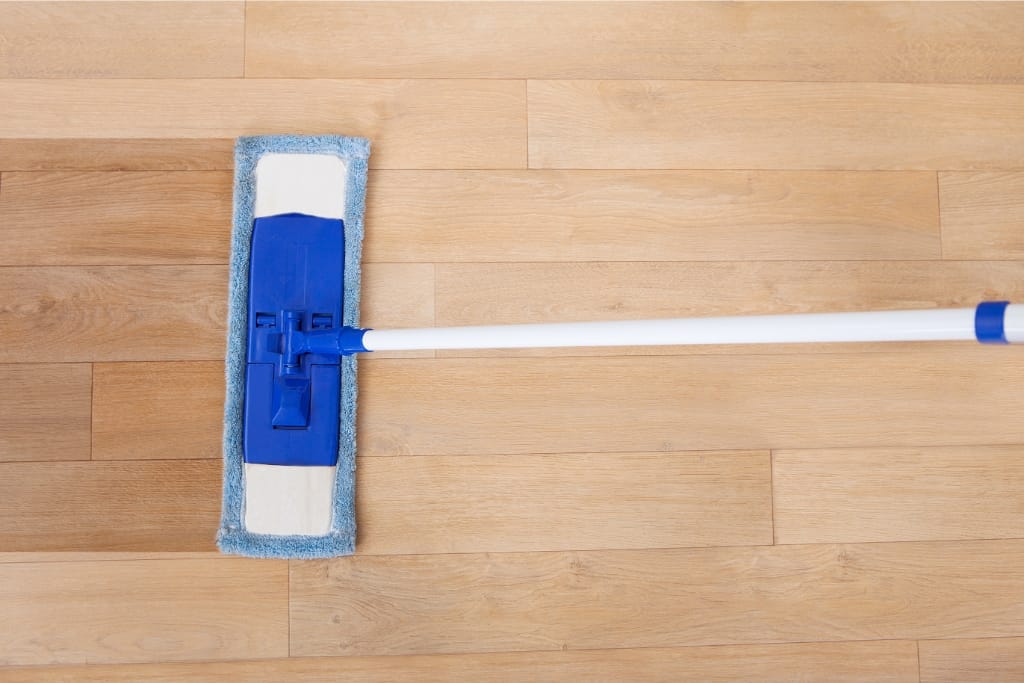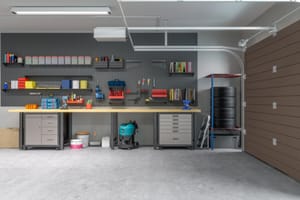Hardwood floors are a timeless and elegant addition to any home. They radiate warmth, charm, and a sense of luxury.
However, maintaining their pristine condition requires dedicated care and attention.
This article will provide you with 10 practical tips to ensure your hardwood floors retain their natural beauty and durability for years to come.
Whether you're a seasoned homeowner or a first-timer, these guides will help you navigate the nuances of hardwood floor care.
1)) Clean Up Spills Immediately
Hardwood floors are susceptible to water damage, so cleaning up spills immediately is important.
Use a microfiber mop or cloth to dry up any liquid before it can seep into the wood.
This will prevent the wood from warping or staining.
Quick Tips for Immediate Clean-Up:
- Act Fast: The longer the spill sits, the more damage it can cause. Therefore, act quickly as soon as you notice any spillage.
- Use Absorbent Material: Use highly absorbent material like a microfiber cloth or a sponge to mop up the spill. Avoid using paper towels that can break apart and leave residue on the floor.
- Dry Thoroughly: After the spill has been absorbed, ensure the area is thoroughly dried to avoid any moisture that may remain on the surface, leading to potential damage.
Cleaning up spills immediately is crucial in maintaining the integrity and beauty of your hardwood floors.
By acting swiftly and using the right materials for cleanup, you can prevent long-term damage like warping or staining.
The key is to absorb the spill, dry the area thoroughly, and keep your floor dry at all times.
This simple routine can greatly extend the life and look of your hardwood floors.
2)) Avoid Harsh Chemicals
When cleaning your hardwood floors, avoid using harsh chemicals that can damage or strip the floors' finish.
Instead, use a pH-neutral cleaner specifically designed for hardwood floors.
Guidelines to Avoid Damaging Chemicals:
- Know Your Cleaners: Get familiar with the ingredients of your cleaning products. Avoid those with strong acids or alkaline, which can dull or etch the floor's finish.
- Choose pH-Neutral Cleaners: Opt for a pH-neutral cleaner specifically designed for hardwood floors. These types of cleaners are mild yet effective, and less likely to harm your floor.
- Natural Alternatives: Consider using natural alternatives like vinegar and water solution. It's an economical, eco-friendly choice that can be very effective for routine cleaning, but remember to use it sparingly as vinegar is acidic.
Avoiding harsh chemicals is another significant step toward preserving your hardwood floors.
By understanding your cleaning products, choosing pH-neutral cleaners, and opting for natural alternatives, you can effectively clean your floors without risking damage to the finish.
Being mindful of the substances you expose your floors to will ensure they retain their shine and durability for years to come.
3)) Use Felt Pads
To prevent scratches on your hardwood floors, place felt pads on the bottom of furniture legs and other heavy objects that may be moved around the room.
This will also make it easier to move furniture without scratching the flooring.
Best Practices for Using Felt Pads:
- Choose Quality Pads: Not all felt pads are created equal. Opt for high-quality, dense felt pads that can withstand pressure and won't easily wear out or fall off.
- Regularly Check and Replace: Felt pads can wear out over time. Make it a habit to check them regularly and replace them as needed to ensure continuous protection for your floors.
- Cover All Furniture: Don't just limit felt pad use to heavy furniture. Even light pieces, such as dining chairs, can cause scratches when moved frequently. Ensure all furniture legs are equipped with felt pads.
Utilizing felt pads is a simple yet effective way to safeguard your hardwood floors from potential scratches and dents.
Investing in high-quality pads, regularly checking and replacing them, and ensuring all pieces of furniture are fitted with pads are practical steps that can greatly reduce the risk of damage to your floors.
Protecting your hardwood floors is all about being proactive and these small measures can lead to substantial benefits in the longevity and appearance of your flooring.
4)) Vacuum And Sweep Regularly
Dirt and debris can accumulate on hardwood floors and cause scratching and other damage.
Sweep or vacuum your floors regularly to keep them clean and looking their best. A soft-bristled broom and a microfiber mop are the best tools for cleaning hardwood floors.
Strategies for Regular Vacuuming and Sweeping:
- Use the Right Tools: Use a soft-bristled broom or a vacuum cleaner with a hardwood setting to avoid scratching the floors. A microfiber mop is also an excellent tool for picking up dust and dirt.
- Establish a Routine: Make sweeping or vacuuming a part of your daily routine. Regular cleaning can prevent the accumulation of dust and dirt that may cause harm to the floor.
- Pay Attention to High Traffic Areas: Areas that receive a lot of foot traffic can accumulate dirt and debris quickly. Pay extra attention to these regions and consider cleaning them more frequently.
Maintaining the cleanliness of your hardwood floors through regular vacuuming and sweeping is a fundamental aspect of floor care.
By using the correct tools, establishing a consistent cleaning routine, and focusing on high-traffic areas, you ensure not only the cleanliness but also the longevity of your floors.
A clean floor is a long-lasting floor, and your consistent efforts will keep your hardwood looking its best for years to come.
5)) Use Rugs And Mats
Placing rugs and mats in high-traffic areas of your home, such as entryways and hallways, can help protect your hardwood floors from wear and tear.
Be sure to use rugs with non-slip backings to prevent slipping accidents.
Effective Use of Rugs and Mats:
- Placement Strategy: Position rugs and mats in high-traffic areas and locations where spills are likely to occur, such as entrances, hallways, and dining areas. This can significantly reduce wear and tear on your hardwood floors.
- Non-Slip Backings: Choose rugs with non-slip backings to prevent them from sliding and causing accidents. It's an important safety measure, especially in busy areas of the house.
- Rug Pads: Consider using rug pads under your area rugs. They provide extra cushioning, protect the floors from any potential dye transfer from the rug, and help extend the life of both your rug and floor.
The strategic use of rugs and mats can play a crucial role in preserving the quality and appearance of your hardwood floors.
By intelligently positioning these coverings in high-traffic or spill-prone areas, using non-slip backings for safety, and leveraging rug pads for extra protection, you can substantially minimize wear and tear on your flooring.
Incorporating these methods into your floor care routine will contribute significantly to maintaining the longevity and beauty of your hardwood floors.
6)) Control Humidity Levels
Hardwood floors are sensitive to changes in humidity levels. Too much moisture can cause the wood to expand and warp, while too little moisture can cause the wood to shrink and crack.
Use a humidifier or dehumidifier to keep your home's humidity levels between 35-55%.
Tips for Controlling Humidity Levels:
- Invest in a Hygrometer: A Hygrometer is a device that measures the amount of humidity in the air. It's a valuable tool for maintaining the ideal humidity level for your hardwood floors.
- Use a Humidifier or Dehumidifier: Depending on the humidity level, use a humidifier to add moisture to the air or a dehumidifier to remove excess moisture. Both can be effective in maintaining an optimal humidity level.
- Seal Your Home Properly: Ensure that your home is well-insulated and sealed, particularly around windows and doors. This can prevent outside moisture from seeping in and impacting indoor humidity levels.
Proactively managing the humidity levels in your home is essential to maintaining the integrity and beauty of your hardwood floors.
By monitoring humidity levels with a hygrometer, effectively using humidifiers or dehumidifiers as needed, and ensuring your home is properly sealed, you can prevent unwanted expansion or shrinkage of the wood.
Keep in mind that your hardwood floors are an investment, and controlling humidity is a key factor in preserving this investment.
7)) Trim Pet Nails
Pets can cause scratches and damage to hardwood floors. To prevent this, trim your pet's nails regularly to keep them from scratching the floors as they run and play.
Guidelines for Trimming Pet Nails:
- Regular Trimming: Make a habit of trimming your pet's nails every few weeks. By keeping them short and dull, you minimize the chance of them scratching your hardwood floors.
- Use the Right Tools: Not all nail trimmers are created equal. Use a pair specifically designed for pets, and ensure they are sharp to make the process easy and safe for your pet.
- Consider Professional Grooming: If you're uncomfortable trimming your pet's nails yourself, consider employing a professional groomer. They have the experience and tools to do the job properly and safely.
The regular trimming of your pet's nails is a simple yet effective way to protect your hardwood floors from potential scratches and damages.
It's essential to use the appropriate tools for the trimming or consider professional grooming services for the best results.
A small effort on your part can make a significant difference in maintaining the beauty and longevity of your hardwood floors.
8)) Prevent Sun Damage
Direct sunlight can cause hardwood floors to fade or discolor over time. Prevent sun damage by closing blinds or curtains during the hottest times of the day or placing UV-blocking window film on windows.
Tips to Prevent Sun Damage:
- Use Window Coverings: Close blinds, curtains, or shades during the sunniest parts of the day to prevent direct sunlight from hitting your hardwood floors. This can significantly reduce fading and discoloration.
- Apply UV-Blocking Window Film: UV-blocking window films can greatly reduce the amount of damaging UV rays that enter your home. These films are available in clear options, so they won’t alter your view.
- Rearrange Furniture and Rugs: Regularly changing the arrangement of your furniture and rugs can help ensure an even exposure to sunlight, preventing certain areas from experiencing excessive fading.
Taking preventative measures against sun damage can significantly aid in preserving the color and integrity of your hardwood floors.
By utilizing window coverings, applying UV-blocking window films, and regularly rearranging your furniture and rugs, you can minimize the adverse effects of UV rays on your flooring.
An ounce of prevention is worth a pound of cure, especially when it comes to protecting the aesthetic appeal of your hardwood floors.
9)) Sand And Refinish
Over time, hardwood floors may become scratched, scuffed, or dull. In this case, consider sanding and refinishing your floors to restore their original beauty.
A professional should do this process to avoid causing more damage to the floor.
Recommendations for Sanding and Refinishing Hardwood Floors:
- Consult a Professional: Sanding and refinishing is a complex process that requires skill and expertise. It's best to hire a professional who understands the intricacies of the task to avoid causing further damage to your floors.
- Choose the Right Finish: There are various types of finishes available, each providing a different level of sheen and protection. Research and consult with your professional to choose the finish that best suits your aesthetic preference and lifestyle.
- Plan for the Downtime: Sanding and refinishing your hardwood floors can be a disruptive process. Be prepared for the noise and dust and plan to stay out of the house if necessary during the process.
The process of sanding and refinishing can breathe new life into your hardwood floors, effectively erasing scratches, scuffs, and dullness.
While it involves investing in professional services and choosing the right finish, the results can significantly enhance the beauty and longevity of your floors.
Bear in mind that this process requires planning for the disruption it may cause.
In the end, restoring your hardwood floors to their original splendor is a clear testament to your commitment to maintaining your home's aesthetic and value.
10)) Schedule Professional Cleaning
Regular cleaning and maintenance by a professional can help preserve the beauty of your hardwood floors.
Professional cleaning includes deep cleaning, polishing, and adding a fresh finish coat.
Guidelines for Scheduling Professional Cleaning:
- Frequency of Cleaning: Depending on the level of traffic your hardwood floors receive, consider scheduling professional cleaning every 6-12 months to maintain their shine and prolong their lifespan.
- Choose a Trusted Professional: Ensure you hire a reputable professional cleaner with experience in hardwood floor maintenance. They will have the right tools and expertise to clean your floors effectively without causing damage.
- Combine with Regular Maintenance: Professional cleaning should not replace your regular floor maintenance. Continue to sweep, dust, and mop your hardwood floors regularly in between professional cleanings.
Scheduling regular professional cleanings can play a pivotal role in preserving the longevity and aesthetic appeal of your hardwood floors.
It not only supplements your routine floor upkeep but also provides deep cleaning and polishing that is often challenging to achieve with standard home cleaning methods.
Continuity in maintenance, both personal and professional, is the key to keeping your hardwood floors in prime condition for years to come.
Conclusion
Maintaining the beauty and longevity of hardwood floors involves regular upkeep, protection from sun damage, professional sanding and refinishing when needed, and routine professional cleanings.
Each of these steps plays a crucial role in preserving the aesthetic appeal and structural integrity of the flooring, while also enhancing its lifespan.
The appearance of your floors can significantly impact the overall look and feel of your home, so investing time and effort in their maintenance is worthwhile.
With the right care, your hardwood floors can remain a timeless and elegant feature of your home for generations to come.
Related Articles and Guides
- How To Clean Hardwood Floors The Right Way
- How To Remove Wax From Hardwood Floors
- How To Remove Duct Tape Residue From Hardwood Floor
- 10 FAQs About How To Properly Clean Hardwood Floors
- 10 Tips For Cleaning Hardwood Floors
- 10 Hacks For Cleaning Grimy Hardwood Floors
Download Our Free E-book!







